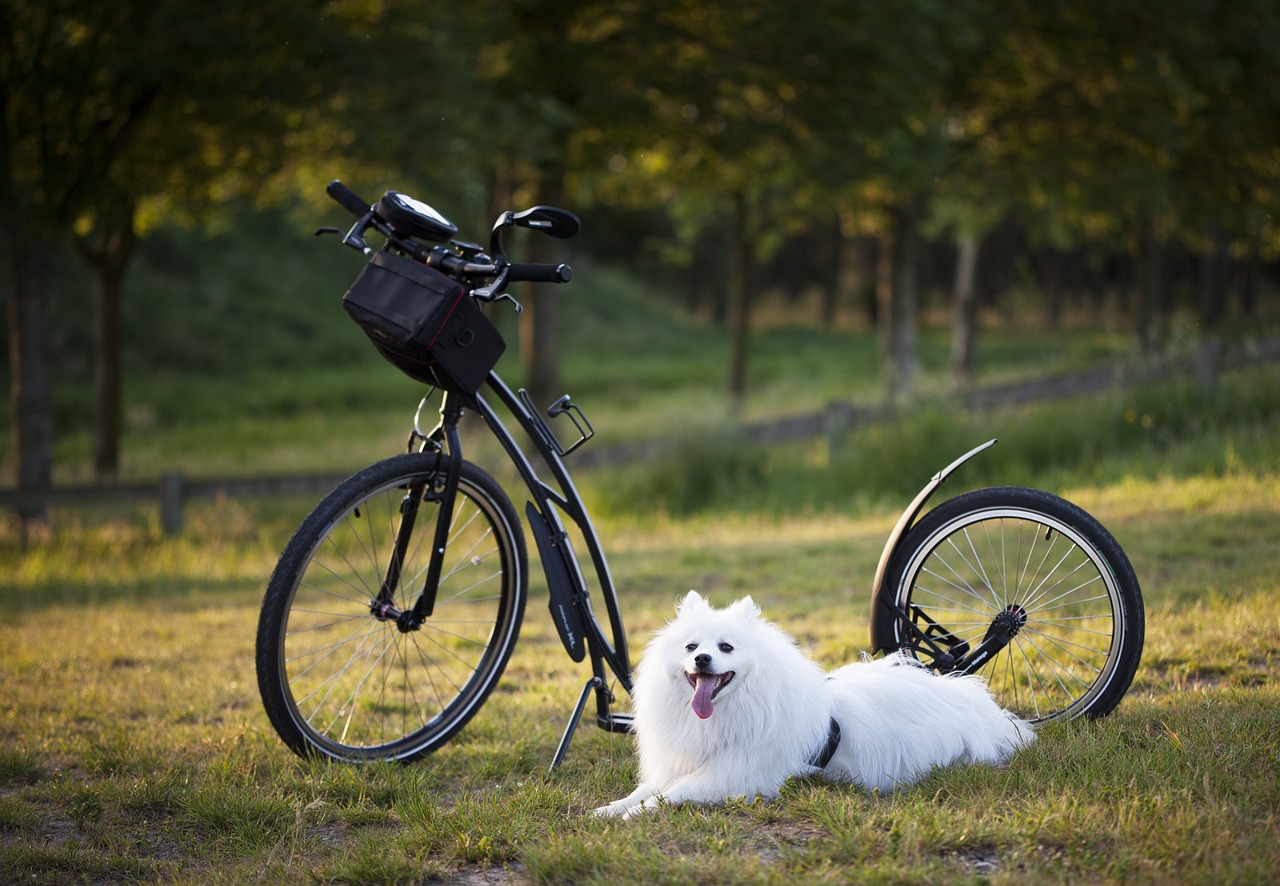How to Help Your Dog Overcome Fear of Steps
Helping your furry friend overcome their fear of steps can be a journey filled with patience, love, and a sprinkle of creativity. Just like us, dogs can experience anxiety, and it’s often rooted in their past experiences or lack of exposure to certain situations. Imagine how daunting it must be for a small pup to face a towering staircase for the first time! The good news is, with the right strategies, you can help your dog conquer their fears and make those steps feel like a walk in the park.
Dogs may develop a fear of steps for several reasons. Perhaps they had a negative experience, like slipping on a step or being startled while climbing. Alternatively, it could stem from a lack of exposure to stairs during their formative months. Understanding the root of their fear is crucial because it allows you to tailor your approach to their needs. Think of it like peeling an onion; you have to remove the layers of fear to get to the core of the issue.
Recognizing when your dog is feeling anxious is essential for addressing their fear effectively. Common signs include hesitation to approach the stairs, whining, or even outright refusal to move. It’s like watching a child hesitate before taking a leap into a swimming pool; they need encouragement and support to take that first step. By being observant, you can gauge how your dog is feeling and adapt your approach accordingly.
Some common behavioral signs of fear include:
- Trembling: This is a clear indicator of anxiety.
- Barking: Excessive barking can signal distress.
- Hiding: If your dog retreats to a corner, they are likely feeling overwhelmed.
These reactions help you understand the severity of your dog's fear, guiding you in choosing the right interventions.
Physical symptoms can also reveal a lot about your dog's emotional state. If you notice them panting or drooling excessively, it might indicate heightened anxiety. These signs are like red flags waving in the wind, urging you to take action. When you identify these symptoms, it allows you to approach the situation with empathy and care, which is crucial for building trust.
Pay attention to vocalizations such as whining or growling, along with body language indicators like lowered ears or a tucked tail. These cues provide critical insights into how your dog feels about the steps. Just like a friend who might express their discomfort through their tone or posture, your dog communicates their feelings through these subtle signals.
It’s important to evaluate how severely your dog reacts to steps. Does your pup freeze in place, or do they try to back away? Understanding the intensity of their fear can help you determine the best strategies for overcoming it. This assessment is like taking the temperature of a situation; knowing where your dog stands will help you choose the right approach to support them effectively.
One of the most effective ways to help your dog overcome their fear is through gradual desensitization. This technique involves slowly introducing your dog to the steps in a controlled manner, allowing them to build confidence over time. Picture it as a gentle introduction to a new friend; you wouldn’t throw them into the deep end right away! Instead, you’d ease them into the relationship.
Using treats and praise while your dog is near the steps can create positive associations. This means that every time your dog approaches the stairs, they should be rewarded with a tasty treat or enthusiastic praise. Think of it as turning a scary movie into a fun adventure; the more positive experiences they have, the less fear they’ll associate with the steps.
Training aids such as ramps or non-slip mats can provide additional support for your dog. These tools can make steps feel less intimidating, promoting a sense of security during their learning process. It’s like giving them a safety net; they’ll feel more confident knowing they have something to help them along the way.
If your dog's fear persists despite your best efforts, don’t hesitate to seek professional help. A trainer or behaviorist can provide specialized strategies tailored to your dog's specific needs. It’s like having a coach in your corner, guiding you through the process and ensuring you’re on the right track.
When selecting a trainer, look for someone with experience in fear-based behaviors. This ensures that your dog receives the best guidance and support to overcome their fear of steps effectively. Just like you wouldn’t hire a coach who specializes in tennis to teach you how to swim, it’s important to find someone who understands your dog’s unique challenges.
Don’t overlook the wealth of online resources available! Videos, forums, and articles can offer valuable tips and community support for dog owners facing similar challenges. Engaging with others who are on the same journey can foster a collaborative environment for learning and growth, making the process feel less isolating.
Q: How long will it take for my dog to overcome their fear of steps?
A: The time it takes varies depending on the severity of the fear and the individual dog. Consistency and patience are key!
Q: Should I force my dog to go up the steps?
A: No, forcing them can increase their anxiety. It’s better to encourage and support them at their own pace.
Q: Can certain breeds be more prone to fear of steps?
A: Yes, some breeds are more sensitive than others, but any dog can develop a fear of steps regardless of breed.
Q: When should I consider professional help?
A: If your dog’s fear doesn’t improve with gradual desensitization or if it worsens, seeking professional help is advisable.

Understanding the Fear of Steps
Dogs are remarkable creatures, full of personality and quirks, but just like humans, they can experience fear. One common fear that many dogs face is the fear of steps. This fear can stem from various factors, and understanding these underlying reasons is crucial for pet owners looking to help their furry friends overcome it. Often, a dog's fear of steps can be traced back to past trauma or simply a lack of exposure to stairs during their formative years. Imagine a puppy who has never encountered stairs before; the first time they see them, they might feel like they are staring at a giant mountain!
Additionally, some breeds are more prone to fearfulness due to their genetic predisposition. For instance, a dog that has experienced a sudden fall or a negative encounter while on stairs may develop a lasting fear. This is not just a simple dislike; it’s a genuine emotional response that can impact their confidence and overall well-being. By taking the time to understand why your dog is afraid of steps, you can create a tailored approach to help them overcome this challenge.
It’s also important to consider the environment in which your dog lives. If your home has steep, narrow, or slippery steps, these can be intimidating for your dog. Just like how we might hesitate to walk on a shaky bridge, your dog may feel similarly apprehensive about navigating stairs that don’t feel secure.
To better illustrate the factors contributing to a dog's fear of steps, here’s a quick breakdown:
| Factor | Description |
|---|---|
| Past Trauma | Negative experiences associated with stairs can lead to lasting fear. |
| Lack of Exposure | Puppies that haven’t been introduced to stairs may find them daunting. |
| Breed Characteristics | Certain breeds may be more prone to anxiety and fearfulness. |
| Environmental Factors | Steep, narrow, or slippery steps can contribute to a dog’s fear. |
Understanding these factors allows you to empathize with your dog’s feelings and approach their fear with patience and care. Remember, your dog is not being stubborn; they are genuinely frightened. With the right strategies and a little bit of love, you can help them conquer their fear of steps, leading to a happier, more confident pup!

Identifying Signs of Fear
Recognizing the signs of fear in your dog is a crucial step in helping them overcome their anxiety about steps. Just like humans, dogs express their emotions through various behaviors and physical cues. If your furry friend seems hesitant or anxious around stairs, it’s essential to pay attention to these signs to tailor your approach effectively. You might notice that they hesitate at the top or bottom of the steps, and this can be a clear indication that something is bothering them. But what exactly should you be looking for?
Common behavioral indicators can range from subtle to pronounced. For instance, if your dog starts to tremble or bark when approaching steps, these are significant signs of fear. They might also try to hide or even refuse to move forward. Observing these reactions not only helps you gauge the severity of their fear but also allows you to implement the right interventions. Remember, each dog is unique, and their responses can vary widely.
Some of the most common behavioral signs that indicate fear include:
- Trembling: A dog that shakes or quivers is often feeling scared or anxious.
- Barking: Excessive barking can be a way for your dog to express their discomfort.
- Hiding: If your dog seeks refuge in a corner or under furniture, it’s a clear sign they are feeling threatened.
Understanding these behaviors is essential for addressing your dog’s fears effectively. The more you observe and note their reactions, the better equipped you'll be to help them navigate their anxiety.
In addition to behavioral signs, dogs often exhibit physical reactions that can indicate heightened anxiety. For example, panting or drooling excessively may signal that your dog is overwhelmed. These physical symptoms are not just mere inconveniences; they are crucial indicators of your dog's emotional state. By identifying these reactions, you can approach your dog with the empathy and understanding they need during this challenging time.
Vocalizations like whining or growling are also significant. A dog that whines when approaching steps is likely expressing their fear or discomfort. Furthermore, pay close attention to their body language. If your dog has lowered ears, a tucked tail, or a stiff posture, these cues suggest that they are not feeling safe. Understanding these vocalizations and body signals provides critical insights into your dog's emotional state regarding steps. It's like learning a new language—once you understand it, you can communicate more effectively with your furry friend.
Evaluating how severely your dog reacts to steps can help you determine the best strategies for overcoming their fear. For instance, if your dog shows mild hesitation, you might start with simple desensitization techniques. However, if their fear is more pronounced, you may need to adopt a more gradual and supportive approach. Tailoring your strategy to the severity of their fear ensures that you’re not only addressing the issue but also fostering a sense of safety and comfort for your dog.
Q: How long does it take for a dog to overcome their fear of steps?
A: The time it takes varies greatly depending on the individual dog and the severity of their fear. Some dogs may take a few weeks, while others might need several months. Patience and consistency are key!
Q: Can all dogs overcome their fear of steps?
A: Most dogs can learn to manage their fears with proper training and support, but some may require professional help if their anxiety is severe.
Q: Should I force my dog to go up or down the steps?
A: No, forcing your dog can worsen their fear. Instead, use positive reinforcement techniques to encourage them at their own pace.
Common Behavioral Indicators
When it comes to understanding your dog's fear of steps, observing their behavioral indicators is crucial. Dogs, much like humans, communicate their feelings through their actions. If your furry friend is hesitant to approach stairs, you might notice a variety of signs that indicate their discomfort. These indicators can range from subtle shifts in behavior to more pronounced reactions. For instance, a dog that is afraid of steps may exhibit trembling, which is a clear sign of anxiety. You might see them shake as they stand at the bottom or top of the stairs, unsure of how to proceed.
Another common behavior is barking. This vocalization can be a way for your dog to express their fear or frustration. They may bark at the steps as if trying to ward off an unseen threat. Additionally, some dogs may resort to hiding, seeking refuge in a nearby room or under furniture when faced with the daunting task of climbing or descending stairs. This instinctual behavior is their way of coping with a situation they perceive as threatening.
It's also essential to consider the context of these behaviors. For example, a dog that usually bounds up and down stairs with ease may suddenly hesitate or refuse to move when faced with a set of steps. This change in behavior could indicate that something has triggered their fear. Observing these behavioral changes can help you pinpoint the severity of the fear and the necessary steps to take in addressing it.
To better understand these common indicators, let’s summarize them in a table:
| Behavior | Description |
|---|---|
| Trembling | Shaking or quivering when near steps, indicating anxiety. |
| Barking | Vocalizing as a response to fear or frustration about the stairs. |
| Hiding | Seeking cover in another room or under furniture to escape the situation. |
Each of these behaviors provides valuable insight into your dog's emotional state. By paying close attention to how your dog reacts when faced with steps, you can tailor your approach to help them overcome their fears. Remember, the goal is to create a safe and supportive environment that encourages your dog to face their fears with confidence.
Q: How long does it take for a dog to overcome their fear of steps?
A: The duration varies depending on the dog and the severity of their fear. Some dogs may adjust within a few days, while others might take weeks or even months. Patience and consistent training are key.
Q: Can I use treats to help my dog overcome their fear of steps?
A: Absolutely! Using treats as positive reinforcement when your dog approaches or successfully navigates steps can create a positive association with the experience.
Q: Should I force my dog to use the steps?
A: Forcing your dog can exacerbate their fear and lead to more anxiety. It's essential to allow them to progress at their own pace.
Q: When should I seek professional help?
A: If your dog's fear is severe or doesn't improve with your efforts, consulting a professional trainer or behaviorist can provide specialized strategies tailored to your dog's needs.
Physical Reactions to Fear
When it comes to our furry friends, understanding their is crucial in helping them cope with their anxieties. Dogs, much like humans, exhibit a variety of signs that can indicate they're feeling scared or uncomfortable. These reactions can range from subtle shifts in behavior to more pronounced physical symptoms. For instance, when a dog is faced with stairs that intimidate them, you might notice them panting heavily or drooling excessively. This is their body's way of signaling distress, akin to how we might sweat or fidget when we're anxious.
It's essential to recognize that these reactions are not just mere quirks but rather significant indicators of their emotional state. If your dog is trembling or shaking, it can be a clear sign that they're feeling overwhelmed. This trembling can sometimes be mistaken for excitement, but when paired with other signs of fear, it becomes evident that your pet is in distress. Moreover, if you observe your dog trying to hide or seeking refuge under furniture, it’s a strong indication that they are feeling particularly vulnerable in that moment.
To help you better understand these physical reactions, here’s a quick overview of some common signs you might observe:
- Panting: Rapid breathing can indicate anxiety.
- Drooling: Excessive saliva may be a sign of fear.
- Trembling: Shaking can signal distress or fear.
- Hiding: Seeking out small, enclosed spaces can indicate a desire to escape from the source of fear.
By paying attention to these physical signs, you can gain valuable insights into your dog's emotional well-being. Just like we might feel our heart race or get butterflies in our stomach when we're scared, dogs experience their own physiological responses to fear. Understanding these reactions allows you to approach your dog's fear with greater empathy and care. Instead of pushing them into situations that scare them, you can create a more supportive environment that helps them feel safe and secure.
Ultimately, being observant and responsive to your dog's physical reactions is a pivotal step in helping them overcome their fear of steps. By fostering a calm and understanding atmosphere, you're not just helping your dog navigate their fears—you're also strengthening the bond you share.
Q: What should I do if my dog refuses to go up or down the stairs?
A: Start by encouraging your dog with treats and praise. Use gradual desensitization techniques, introducing them to the stairs slowly and positively.
Q: How long will it take for my dog to overcome their fear of steps?
A: Every dog is different, and the time it takes can vary. Patience is key! Some dogs may take weeks, while others might need months to feel comfortable.
Q: Should I force my dog to use the stairs?
A: No, forcing a dog can exacerbate their fear. It's essential to let them progress at their own pace and to create a positive association with the stairs.
Q: Can professional help make a difference?
A: Absolutely! A professional trainer or behaviorist can provide tailored strategies and support to help your dog overcome their fear effectively.
Vocalizations and Body Language
When it comes to understanding your dog's fear of steps, paying attention to their vocalizations and body language is crucial. Dogs communicate a lot through sounds and physical cues, and recognizing these can help you gauge their emotional state. For instance, if your dog is whining or growling, it’s a clear indication that they are feeling uncomfortable or anxious about the stairs. These vocalizations often serve as a way for them to express their fear, and as a caring pet owner, it’s your job to decode these messages.
Body language can be even more telling. When a dog is afraid, you might notice their ears are lowered or their tail is tucked between their legs. This posture signals submission and fear, suggesting that your furry friend is not just hesitant, but truly scared. Additionally, if your dog is cowering or trying to hide when near steps, these behaviors are significant indicators of their anxiety level. It’s essential to observe these signs closely to understand how your dog feels about the situation.
Another important aspect to consider is how your dog reacts physically when faced with steps. If they exhibit signs of tension—such as stiffening their body or avoiding eye contact—it’s a clear sign that they are overwhelmed. On the flip side, if they seem relaxed and approach the steps with a wagging tail, they might be feeling a bit more confident. This duality in behavior shows just how complex their emotional responses can be.
To further help you interpret these signs, here’s a quick reference table summarizing common vocalizations and body language cues associated with fear:
| Vocalization | Body Language | Interpretation |
|---|---|---|
| Whining | Tucked tail | Fear or anxiety |
| Growling | Lowered ears | Discomfort or warning |
| Barking | Cowering | Frustration or fear |
| Silence | Stiff body | Overwhelmed or unsure |
Understanding these vocalizations and body language cues is not just about recognizing fear; it’s about building a deeper bond with your pet. By being attuned to their needs, you can create a more supportive environment that encourages them to face their fears head-on. Remember, your dog looks to you for guidance, and by responding appropriately to their vocalizations and body language, you can help them navigate their fear of steps with more confidence.
- What should I do if my dog refuses to go up or down the stairs?
Start by encouraging them with treats and positive reinforcement. Gradually desensitize them by allowing them to explore the steps at their own pace.
- How long will it take for my dog to overcome their fear of steps?
The timeframe varies for each dog. Some may take a few days, while others might need weeks or even months. Patience and consistency are key.
- Should I consult a professional trainer?
If your dog's fear is severe or doesn't improve with your efforts, seeking help from a professional trainer or behaviorist can provide tailored strategies.
Assessing the Severity of Fear
Understanding the severity of your dog's fear of steps is a crucial step in tailoring an effective approach to help them overcome it. Just like humans, dogs exhibit a range of reactions to fear, and these can vary significantly from one pup to another. So, how do you gauge just how frightened your furry friend is? It starts with observation. Pay close attention to their body language and vocalizations. For instance, if your dog approaches the steps with a stiff body posture or a low tail, these are signs of apprehension. On the other hand, if they are actively avoiding the area, it is a clear indicator that their fear is more pronounced.
To further assess the severity, consider the context in which your dog expresses fear. Is it only when they are at the top of the stairs, or does it occur when they are merely near them? This distinction can help you identify whether the fear is linked to climbing, descending, or both. Additionally, you can create a simple scale to categorize their reactions:
| Fear Level | Description |
|---|---|
| 1 - Mild | Shows slight hesitation but will attempt to go up or down with encouragement. |
| 2 - Moderate | Exhibits signs of anxiety such as whining or pacing but can be coaxed with treats. |
| 3 - Severe | Refuses to approach the stairs, displaying physical signs of distress like trembling or barking. |
By categorizing your dog's fear level, you can tailor your training methods to suit their needs. For instance, a dog rated at level one may benefit from simple encouragement and treats, while a level three dog might require a more gradual approach, perhaps starting with just sitting near the steps and gradually working your way up to climbing them. This method not only helps in understanding your dog's fear but also allows you to track their progress over time.
Ultimately, the goal is to create a safe and supportive environment where your dog feels comfortable exploring the steps at their own pace. Remember, patience is key! Every dog is unique, and what works for one may not work for another. So, keep a close eye on your pup's reactions and adjust your approach accordingly.
- How long will it take for my dog to overcome their fear of steps? The timeline varies for each dog. It depends on their individual temperament, past experiences, and the consistency of your training efforts.
- Should I force my dog to use the stairs? No, forcing your dog can increase their anxiety. Instead, allow them to explore the stairs at their own pace.
- Can I use toys to help my dog feel more comfortable with steps? Absolutely! Using toys can create a fun and positive association with the steps.
- What if my dog has a physical limitation? If your dog has physical challenges, consult with a veterinarian for alternative solutions, such as ramps or other aids.

Gradual Desensitization Techniques
When it comes to helping your furry friend conquer their fear of steps, can be your best ally. This method is all about patience and positive reinforcement. Think of it like teaching a child to swim; you wouldn’t throw them into the deep end right away, right? Instead, you’d start in the shallow end, gradually introducing them to deeper water as they become more comfortable. Similarly, with your dog, you want to introduce them to steps in a way that feels safe and manageable.
The first step in this journey is to create a calm and positive environment around the steps. Begin by simply allowing your dog to observe the steps from a distance. This is where positive associations come into play. You can use treats or their favorite toy to create a positive experience. For instance, when your dog is near the steps and appears relaxed, reward them with a treat or praise. This helps them associate the steps with something good, rather than something to fear.
Next, you can start to decrease the distance gradually. Move a few steps closer to the stairs and repeat the rewarding process. If your dog shows signs of anxiety, don’t rush them. Go back to a distance where they feel comfortable and try again. The key here is to proceed at a pace that suits your dog. Some dogs may need more time than others, and that’s perfectly okay!
Once your dog seems comfortable being near the steps, you can start introducing them to the idea of stepping onto the first step. You might want to use a training aid like a non-slip mat to provide extra comfort. This can make the surface feel less intimidating. Encourage your dog to place their front paws on the first step while you’re right there beside them, offering praise and treats for any progress they make. This is where the magic of positive reinforcement shines!
Here’s a simple progression you can follow:
| Step | Action | Reward |
|---|---|---|
| 1 | Observe steps from a distance | Treats and praise |
| 2 | Approach steps | Treats and praise |
| 3 | Place front paws on the first step | Treats and praise |
| 4 | Step up onto the first step | Treats and praise |
| 5 | Step down from the first step | Treats and praise |
As your dog becomes more confident, you can gradually encourage them to move to the next step and eventually up and down the entire flight. Always keep an eye on their body language; if they show signs of stress, take a step back and allow them to regroup. The goal is to build their confidence, not to overwhelm them.
Lastly, remember that consistency is key! Make these training sessions a regular part of your routine. Short, frequent sessions are often more effective than long, drawn-out ones. And don’t forget to celebrate every little victory! Each step your dog takes is a step closer to overcoming their fear, and that’s something worth celebrating.
- How long will it take for my dog to overcome their fear of steps? - Every dog is different. Some may take a few days, while others might need weeks or even months. Patience is crucial!
- What if my dog refuses to go near the steps? - Go back to a distance where they feel comfortable and try again. Use treats and praise to encourage them.
- Should I use a leash during training? - A leash can help keep your dog focused and prevent them from running away. Just ensure it’s loose to avoid adding pressure.
Creating Positive Associations
Creating positive associations is one of the most effective strategies for helping your dog overcome their fear of steps. Think of it like building a bridge of trust between your furry friend and those intimidating stairs. The goal is to turn what was once a source of anxiety into a place of fun and excitement. This process involves patience, consistency, and a sprinkle of creativity!
Start by introducing your dog to the steps in a calm and controlled environment. This means no distractions and plenty of space for your dog to feel safe. Use treats and praise as your main tools. For instance, when your dog approaches the steps, reward them with a tasty treat and a cheerful “good job!” This simple act can transform their perception of the steps from something scary into a rewarding experience. It’s like giving them a little trophy for bravery!
To make this process even more effective, consider using a clicker. A clicker is a small device that makes a distinct sound when pressed, signaling to your dog that they’ve done something right. Pairing the click sound with treats can reinforce positive behavior. For example, click when your dog takes a step closer to the stairs and immediately follow it up with a treat. Over time, your dog will begin to associate the sound of the clicker and the presence of the stairs with positive outcomes.
Another fun way to create positive associations is through games. If your dog enjoys playing fetch or tug-of-war, incorporate the steps into these games. For example, you might throw a toy up a few steps and encourage your dog to retrieve it. Make sure to cheer them on enthusiastically! This not only makes the steps feel like a part of playtime but also helps them learn that going up or down isn’t something to fear.
Here’s a quick table summarizing some techniques for creating positive associations:
| Technique | Description |
|---|---|
| Treat Rewards | Give treats when your dog approaches the steps to reinforce positive behavior. |
| Clicker Training | Use a clicker to mark desired behaviors, followed by a treat. |
| Playful Engagement | Incorporate the steps into games to make them feel less threatening. |
Ultimately, the key to success lies in consistency. Repeat these exercises regularly, and gradually increase the level of difficulty. For example, once your dog is comfortable with standing at the bottom of the steps, encourage them to take a step up, then reward them. Slowly but surely, your dog will begin to see the stairs as a place of joy rather than fear.
Remember, every dog is unique, and what works for one may not work for another. Be patient and observant. If your dog seems overwhelmed, take a step back and allow them to progress at their own pace. With time and positive reinforcement, you’ll help your dog build the confidence they need to conquer those steps!
- How long will it take for my dog to overcome their fear of steps? - The timeline varies for each dog. Some may take a few days, while others might need weeks. Consistency is key!
- Can I use negative reinforcement to correct my dog’s fear? - No, negative reinforcement can worsen anxiety. Focus on positive reinforcement instead.
- What if my dog doesn’t respond to treats? - Try different rewards, such as favorite toys or extra playtime. Find what motivates your dog!
- Should I consult a professional if my dog’s fear is severe? - Yes, a professional trainer or behaviorist can provide tailored strategies for overcoming extreme fears.
Utilizing Training Aids
When it comes to helping your dog overcome their fear of steps, utilizing training aids can be a game changer. These tools not only provide physical assistance but also create a more comfortable and secure environment for your furry friend. Imagine your dog looking at a daunting flight of stairs and feeling a wave of anxiety wash over them. Now, picture introducing a non-slip mat at the base of those steps. Suddenly, the surface feels more stable, and your dog is more inclined to give it a try.
One effective training aid is a ramp. Ramps can be particularly helpful for dogs that are small or have physical limitations. By offering an alternative to traditional stairs, ramps can ease the transition and build your dog's confidence. You can start by placing the ramp next to the steps, allowing your dog to explore it at their own pace. Gradually, as they become more comfortable, you can encourage them to use the ramp to access higher areas without the stress of steps.
Additionally, consider using treats and toys as motivational tools. When your dog approaches the steps or even just the area around them, reward them with a treat or their favorite toy. This creates a positive association with the steps, transforming what was once a source of fear into a place of fun and reward. It's like turning a scary rollercoaster into a thrilling ride they can't wait to experience!
Moreover, visual cues can also play a significant role in easing your dog's fears. For instance, you can place colorful stickers or markers on the steps to make them more inviting. This simple change can capture your dog's attention and encourage them to explore the steps further. Remember, the goal is to create a safe space where your dog feels secure enough to conquer their fears.
Incorporating these training aids into your strategy can significantly enhance your dog's learning experience. It's essential to be patient and supportive throughout this process. Just like humans, dogs need time to adjust to new situations. By providing them with the right tools and a nurturing environment, you'll be well on your way to helping your furry companion overcome their fear of steps.
- How long does it take for a dog to overcome their fear of steps?
Every dog is different, but with consistent training and positive reinforcement, many dogs can show significant improvement within a few weeks. - What should I do if my dog refuses to go near the steps?
Start by creating a positive environment around the steps. Use treats, toys, and praise to encourage them to approach without pressure. - Are there specific breeds that are more prone to fear of steps?
While any dog can develop a fear of steps, smaller breeds or those with previous negative experiences may be more susceptible. - Can professional training help with my dog's fear of steps?
Yes! A professional trainer can provide tailored strategies and support to help your dog feel more comfortable and confident.

Professional Help and Resources
If your dog's fear of steps persists despite your best efforts, seeking professional help can be a game changer. Sometimes, the challenges our furry friends face require more than just patience and treats. Professional trainers and behaviorists have the expertise to assess your dog's specific situation and develop tailored strategies to help them overcome their fears. It's like having a personal coach for your pet, guiding them through their emotional hurdles.
When searching for the right trainer, consider their experience with fear-based behaviors. Not all trainers are equipped to handle anxiety issues, so it's essential to choose someone who understands the nuances of canine psychology. Look for reviews or testimonials from other dog owners to ensure you're making an informed decision. You wouldn’t want to hire a coach who specializes in basketball to train for a marathon, right? The same logic applies to your dog's training.
In addition to in-person help, there are numerous online resources available that can provide valuable insights and support. Websites, forums, and social media groups dedicated to dog training often share tips, success stories, and advice from experienced pet owners and trainers. These platforms can foster a sense of community where you can connect with others who are facing similar challenges.
For example, you might find video tutorials that demonstrate desensitization techniques or hear from other owners who have successfully helped their dogs conquer their fear of steps. It's like having a virtual support group at your fingertips, offering encouragement and new ideas to explore.
To help you navigate the world of professional help and resources, here’s a quick comparison table of potential options:
| Type of Resource | Description | Benefits |
|---|---|---|
| Professional Trainers | Experts who work directly with dogs to modify behavior. | Personalized guidance, hands-on training, and tailored strategies. |
| Behaviorists | Specialists in animal behavior, focusing on emotional issues. | In-depth assessments and behavioral modification plans. |
| Online Resources | Websites, forums, and videos offering tips and community support. | Access to a wealth of information and shared experiences. |
Remember, every dog is unique, and what works for one might not work for another. Don't hesitate to reach out for help if you feel overwhelmed. Your dog's journey to overcoming their fear of steps is not just about the steps themselves but about building trust and confidence in their world. With the right resources and support, you can transform their anxiety into a sense of security and adventure!
- What are the signs that my dog is afraid of steps?
Common signs include hesitation, whining, trembling, and refusal to move. - How long will it take for my dog to overcome their fear?
The time varies by dog; some may take weeks, while others may need months. - Can I train my dog to overcome fear on my own?
Yes, many owners successfully help their dogs with patience and consistent training, but professional help can expedite the process.
Choosing the Right Trainer
When it comes to helping your furry friend overcome their fear of steps, selecting the right trainer is absolutely crucial. A good trainer can make all the difference in your dog’s journey towards confidence and comfort. But how do you find the right one? First, consider their experience with fear-based behaviors. You wouldn’t want to take your dog to someone who specializes in obedience training if your pup’s issue is rooted in fear. Instead, look for trainers who have a background in behavioral training, specifically with dogs that exhibit anxiety or fear responses.
Another key factor is the trainer’s philosophy on dog training. Positive reinforcement techniques are generally the most effective and humane methods for addressing fear in dogs. Ask potential trainers about their training methods and observe how they interact with dogs. A trainer who uses harsh corrections or negative reinforcement might exacerbate your dog's fears rather than alleviate them. Instead, look for someone who encourages a gentle, patient approach, using treats, praise, and encouragement to help your dog feel safe.
It's also beneficial to seek out recommendations from fellow dog owners or veterinarians. They can provide insights into trainers who have successfully helped dogs with similar fears. If you have access to online platforms, consider checking reviews and testimonials. This can give you a broader perspective on the trainer's reputation and effectiveness.
Finally, don’t hesitate to ask for a trial session. This can be a great opportunity to see how the trainer interacts with your dog and whether your dog responds positively to their methods. Remember, the goal is to create a safe and trusting environment for your furry friend. If the trainer seems to understand your dog's needs and your dog appears comfortable, you may have found the right match!
- What experience do you have with dogs that have fear-based behaviors?
- Can you explain your training philosophy and methods?
- Are you certified or have any special training qualifications?
- Can you provide references or testimonials from previous clients?
- What is your approach to creating a positive experience for fearful dogs?
Ultimately, the right trainer will not only help your dog navigate their fear of steps but will also empower you with the tools and knowledge needed to support your dog’s progress. Remember, patience and persistence are key, and with the right guidance, your dog can learn to conquer their fears one step at a time!
Q: How long will it take for my dog to overcome their fear of steps?
A: The duration varies based on the severity of the fear and the individual dog's temperament. Some dogs may take a few weeks, while others might need several months of consistent training.
Q: Can I train my dog myself instead of hiring a professional?
A: Yes, you can use positive reinforcement techniques to help your dog. However, if the fear is severe, a professional trainer can provide tailored strategies and support.
Q: What should I do if my dog shows aggression towards the steps?
A: If your dog displays aggressive behavior, it’s crucial to consult with a professional trainer or behaviorist who can help address both the fear and aggression safely.
Q: Are there specific breeds that are more prone to fear of steps?
A: Any breed can develop a fear of steps, but dogs that are naturally more timid or have had negative experiences may be more susceptible.
Q: How can I support my dog during the training process?
A: Be patient, provide plenty of encouragement, and celebrate small victories. Your calm demeanor will help your dog feel more secure as they face their fears.
Utilizing Online Resources
In today's digital age, the internet is a treasure trove of information, especially when it comes to helping our furry friends overcome their fears. If your dog is struggling with a fear of steps, there are numerous online resources that can provide you with the necessary tools and support. From instructional videos to forums filled with shared experiences, these platforms can be invaluable in your journey to help your dog feel more comfortable.
One of the most effective ways to utilize online resources is to watch training videos. Platforms like YouTube feature countless channels dedicated to dog training, where experienced trainers demonstrate techniques for desensitization and positive reinforcement. These visual aids can make it easier for you to understand how to approach your dog's fear. For example, seeing a trainer guide a dog up and down steps with treats can inspire you to try similar methods at home.
Furthermore, consider joining online communities or forums where dog owners share their stories and advice. Websites like Reddit or dedicated pet forums often have sections specifically for behavioral issues. Here, you can post questions, share your experiences, and receive feedback from others who have faced similar challenges. The sense of community can be incredibly reassuring, reminding you that you’re not alone in this journey.
Additionally, many professional trainers and behaviorists maintain blogs or social media pages where they provide tips and insights. Following these experts can keep you updated on the latest training techniques and approaches. Some even offer free resources like eBooks or downloadable guides that can be a great addition to your training toolkit.
Here’s a quick table summarizing some useful online resources:
| Resource Type | Examples | Benefits |
|---|---|---|
| Training Videos | YouTube, Vimeo | Visual guidance on techniques |
| Online Forums | Reddit, DogForum.com | Community support and shared experiences |
| Professional Blogs | Trainers' websites, social media | Expert tips and advice |
By leveraging these online resources, you can create a comprehensive approach to help your dog conquer their fear of steps. Remember, patience is key! Celebrate small victories along the way and don’t hesitate to reach out for help when you need it. Your dog’s journey to confidence is a shared adventure, and with the right tools, you can make it a successful one.
- How long will it take for my dog to overcome their fear of steps? - The timeline varies for each dog. Some may adapt quickly, while others might need weeks or even months of consistent training.
- Are there specific breeds that are more prone to fear of steps? - While any dog can develop a fear of steps, some breeds may be more sensitive due to their temperament or past experiences.
- Should I force my dog to use the steps? - No, forcing your dog can increase their anxiety. It's essential to use positive reinforcement and gradual exposure instead.
Frequently Asked Questions
- What causes my dog to be afraid of steps?
Dogs can develop a fear of steps for various reasons, including past negative experiences, lack of exposure to stairs during their formative months, or even physical discomfort. Just like humans, dogs can associate certain environments with fear, especially if they have had a traumatic experience in that setting.
- How can I tell if my dog is afraid of steps?
Look for signs such as hesitation, whining, or refusal to approach the stairs. Other indicators include trembling, barking, or hiding. Physical reactions like panting or drooling can also signal anxiety. Pay attention to your dog's body language; lowered ears, a tucked tail, and avoidance behaviors are strong indicators of fear.
- What are gradual desensitization techniques?
Gradual desensitization involves slowly introducing your dog to steps in a controlled and positive manner. Start by letting your dog observe the steps from a distance, then gradually move closer, rewarding them with treats and praise. This method helps build their confidence and reduces anxiety over time.
- How can I create positive associations with steps?
Use treats and verbal praise when your dog is near the steps. You can also encourage them to play or engage in fun activities near the stairs. The goal is to make the experience enjoyable so that your dog begins to associate steps with positive feelings rather than fear.
- Are training aids effective in helping my dog?
Absolutely! Training aids like ramps or non-slip mats can provide additional support and comfort for dogs. These tools make steps less intimidating and can help your dog feel more secure as they learn to navigate stairs.
- When should I seek professional help for my dog's fear?
If your dog's fear of steps persists despite your efforts, it may be time to consult a professional trainer or behaviorist. They can provide specialized strategies tailored to your dog's needs and help you implement effective techniques to overcome this fear.
- How do I choose the right trainer for my dog?
Look for a trainer with experience in handling fear-based behaviors. It's essential to find someone who understands your dog's specific challenges and can offer a compassionate, effective approach. Don't hesitate to ask for references or check online reviews!
- What online resources can I use for additional support?
There are numerous online resources available, including training videos, forums, and articles that provide valuable tips. Engaging with community support can foster a collaborative learning environment where you can share experiences and gather insights from other dog owners facing similar challenges.



















